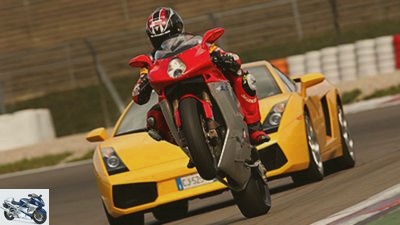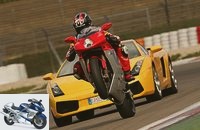Menus

Gargolov
Car versus motorcycle: Lamborghini Gallardo versus MV Agusta F4 1000 S on the racetrack
Summit meeting
Top automotive engineering meets the finest motorcycle engineering, super sports car meets super sports motorcycle. A current thousand can hold a candle to a modern high-performance racer? Lamborghini Gallardo and MV Agusta F4 1000 S meet on the Grand Prix circuit of the Nurburgring.
You could watch this story
fix a lap time and thus end any round table discussion after a few sentences. Because one of the two Italian high-tech devices gives the answer to the question of the fastest flying lap in an almost alarmingly clear way. But then little would be told, a lot of exciting things would be gone-
fall. For example, how it feels,
driving one of the rare, incredibly eye-catching Lamborghini Gallardo. And above all, how an incredibly strong MV Agusta F.4 1000 S in comparison.
The Lambo itself strengthens self-confidence. Anyone who has the honor of moving the flat flounder on public roads is on the winning side of the
Arrived in life. Even a Porsche Turbo crumbles out of the fast lane when it sees this yellow wedge in the rearview mirror. In the city the mouths of bystanders stay open when the traffic light stops, girlies throw their hair in them
Neck, neighbors pull out their cameras. People you’ve never met suddenly seem to know you, you have a lot of new friends. It helps to let the classy 500-hp ten-cylinder roar with relish and, thanks to the semi-automatic, shoot away at lightning speed.
In contrast, an MV is almost inconspicuous. A motorcycle that usually means nothing to the common driver. Only the two-wheeler connoisseur reveals the beauty of its slim shape, its wonderfully combined frame tubes and aluminum parts, its unique exhaust system with the four flutes in the rear when looking at the MV. The sound, however, is pithy, but the sound of an in-line four-cylinder that you’ve heard once or twice. He fights in vain against the roar of Gallardo. How you can smuggle so much sound past the licensing authority, probably only the responsible measuring engineer knows.
The V10 roars even louder in the cockpit, where the driver crouches behind the steering wheel like a map and has fun with the shift paddles, which change gears electro-hydraulically and even double-declutch precisely when downshifting. E-Gear is the name of the gearbox, costs almost half an MV with a meager 9280 euros extra charge, but lets you enjoy the performance of the engine first-class. From 3000 rpm it goes ahead, at 5500 rpm the second wind comes, and from 7000 rpm storm is on the program. At 8000 rpm
switched, after 13 seconds and just in the fourth 200 km / h are reached. The five-liter unit pushes on impressively and drives the Lambo to well over 300 km / h, which the all-wheel-drive flat piece masters with remarkable stability.
It is much more difficult for the MV Agusta driver and has to consider a lot more. Real 165 hp have to be kept in check, without any driving aids. Just the throttle, the clutch and you. Everything can be fine ?? or not. Because in the first, the thousand increases from 9000 rpm, in the second, if things go stupid, still at 11,000 rpm. Only at 12300 rpm is the end of the brute force. Rodeo with a bull gone wild, the Lamborghini looks like a tame calf in comparison, although Gallardo is the name of a fighting bull.
Only the good make it on the MV
the 200 mark in eight seconds, and anyone who has experienced the 300 km / h top speed knows that the wind can turn into an inferno. In the Lambo you experience this speed almost like a video game with Dolby Surround Sound, on the MV you crouch down on the handlebars and fight emotionally for survival, that’s how vulnerable you feel on the bike in relation to the car.
But now the Nurburgring GP track. Ex-DTM driver Manfred Wollgarten in a Lamborghini against BMW Boxer Cup driver Markus Barth on the MV Agusta. Ever-
the meter is recorded in memory
of the MOTORRAD GPS measuring system. A great thing because it measures the speed at every point in time driven; as a result, you can determine exactly where which vehicle is driving and how fast. The track isn’t even completely dry after a downpour, so the motorcycle doesn’t stand a chance?
Wollgarten begins. The Gallardo hissed out of the pit lane, passed after a short while on the first flying lap and burned three fast laps into the asphalt. “It doesn’t go much faster,” says the veteran. “The brakes stink a lot anyway.” The stopwatch shows 2.23.45 minutes for the fastest lap, not bad for the 5.04 kilometer circuit.
»Burn now ?? I’ll take one, ”takes
Markus Barth and leaves the MV
on the rear wheel out of the pit lane
screech. Like a cannonball comes
he passed his flying lap on
Pit building breaks the clatter of the four-cylinder, cheering in the highest tones. The second lap is the fastest, in the third Barth rides into the botany and comes into the pits with dirty tires. Everyone stared at the stopwatch in disbelief. 2.13.55 minutes! The MV Agusta completes the lap almost exactly ten seconds faster. Nobody can believe that, but the recording confirms the sensation: Even a 500 hp super sports car with four-wheel drive has no chance against the thousands.
Why is that? A look at the speeds enlightened. On the home straight the Lambo 216, the MV 250 km / h; In the Hatzenbach-Bogen, Barth has to accelerate again at 241 km / h, while Wollgarten is still on top at 221 km / h. The 220 kilogram MV simply accelerates much better than the 1613 kilogram Lamborghini. The fact that the car is faster in all corners and not on the brakes doesn’t help much either
is to be defeated. The advantage of the motorcycle becomes particularly clear when accelerating uphill after the Dunlop hairpin. Over the few 100 meters, the bike manages to increase the speed from 54 to 190 km / h, the super sports car struggles from 75 to 153 km / h.
Physics provides clarity. While with the MV, every horsepower including the driver has to accelerate 1.82 kilograms, every Lambo horse has to propel 3.39 kilograms. To catch up with the MV, the sports car would need 970 hp or should weigh only 875 kilograms.
Incidentally, no other road-legal land vehicle achieves the power-to-weight ratio of today’s supersport thousands. Any questions?
Buy complete article

Car versus motorcycle: Lamborghini Gallardo versus MV Agusta F4 1000 S on the racetrack
Summit meeting
Technical data: Lamborghini Gallardo
engine
Water-cooled ten-cylinder 90-degree V-engine, crankshaft lying lengthways, two overhead, chain-driven camshafts with variable control, four valves per cylinder, bucket tappets with hydraulic valve clearance compensation, dry sump lubrication, injection, regulated catalytic converters, permanent all-wheel drive with viscous coupling, variable drive torque distribution (normal 30% front, 70% rear), limited slip differential 45% rear, mechanical six-speed gearbox with electro-hydraulic control (E-Gear), ESP.
Bore x stroke 82.5 x 92.8 mm
Cubic capacity 4961 cm3
Compression ratio 11: 1
Rated output 368 kW (500 hp) at 7800 rpm
Max. Torque 510 Nm at 4500 rpm
Pollutant values (homologation) in g / km
CO 1.119 / HC 0.102 / NOx 0.079
landing gear
Independent suspension with double wishbones, coil springs, shock absorbers, stabilizers front and rear, hydraulic two-
Circular brake with brake booster, internally ventilated disc brakes at the front, Ø 365 mm, eight-piston fixed calipers, internally ventilated disc brakes at the rear, Ø 335 mm, four-piston fixed calipers, ABS.
Cast aluminum wheels 8.50 J x 19; 11.00 J x 19
Tires 235/35 ZR 19; 295/30 ZR 19
Pirelli P Zero Rosso tires tested
mass and weight
Wheelbase 2560 mm, weight with a full tank of 1613 kg, payload 188 kg, tank capacity 90
liter.
Two year guarantee
Service intervals every 10000 km
Colors yellow, orange, silver, black
Base price 139,200 euros
Price test car ** 152 308 euros
Technical data: MV Agusta F4 1000 S
engine
Water-cooled four-cylinder four-stroke in-line engine, two overhead, chain-driven camshafts, four valves per cylinder, arranged radially, bucket tappets, wet sump lubrication, injection, Ø 46 mm, uncontrolled catalytic converter with secondary air system, 650 W alternator, 12 V / 9 Ah battery, hydraulic-
Lically operated multi-disc oil bath clutch, six-speed gearbox, O-ring chain.
Bore x stroke 76.0 x 55.0 mm
Displacement 998 cm3
Compression ratio 13: 1
rated capacity
122 kW (166 hp) at 11750 rpm
Max. Torque 109 Nm at 10200 rpm
Pollutant values (homologation) in g / km
CO 2.096 / HC 0.625 / NOx 0.186
landing gear
Steel tubular frame, upside-down fork, Ø 49 mm, adjustable spring base, rebound and compression damping, single-sided swing arm made of aluminum, central spring strut with lever system, adjustable spring base, rebound and compression damping, double disc brake at the front, Ø 310 mm, six-
Fixed piston calipers, rear disc brake, Ø 210 mm, four-piston fixed caliper.
Cast aluminum wheels 3.50 x 17; 6.00 x 17
Tires 120/65 ZR 17; 190/50 ZR 17
Tires in the Michelin Pilot Race test
mass and weight
Wheelbase 1408 mm, steering head angle 66 degrees, caster 98 mm, spring travel f / r 118/120 mm, seat height * 810 mm, weight with a full tank * 220 kg, load * 199 kg, tank capacity 21 liters.
Two year guarantee
Service intervals every 6000 km
Colors red / silver, silver / blue, silver / yellow
Price 19800 euros
Additional costs 200 euros
Related articles
-
Exclusive driving report MV Agusta F4 1000 Mamba T-1
Jahn Exclusive driving report MV Agusta F4 1000 Mamba T-1 Strong poison Only one person is allowed to make an MV Agusta F4 1000 lighter, faster, stronger and more elegant: …
-
MV Agusta Brutale 1000 series Oro
Motorbike fair in Milan EICMA 2019 Presented by Photo: Jorg Kunstle 13 pictures MV Agusta 1/13 MV Agusta presented the Brutale 1000 at EICMA 2018 …
-
MV Agusta Brutale 800 versus Triumph Street Triple R
Jahn 15 pictures Jahn 1/15 The hot naked bikes: MV Agusta Brutale 800 and Triumph Street Triple R in a comparison test. Jahn 2/15 The …
-
Yamaha FZR 1000 Genesis versus Yamaha YZF-R1
Yamaha FZR 1000 Genesis versus Yamaha YZF-R1 Yamaha’s thousands: The trendsetter With 135 HP in the unthrottled version, five-valve technology, 45 degrees after …
-
Honda CB 1000 R, MV Agusta Brutale 1090 RR ABS and Triumph Speed Triple R in the test
34 photos www. 1/34 The four-cylinder of the MV Agusta Brutale 1090 RR is extremely easy to turn, from which it draws its high…
-
Gargolov Premiere: MV Agusta The new MV Agusta F 4 1000 R Content of In 1999, motorcycle designer Massimo Tamburini delivered another millennium design…
-
Endurance test interim report MZ 1000 S
Jahn endurance test interim balance sheet MZ 1000 S Der Ost-Bote More exclusive than an MV, more emotional than most Japanese and more reliable than many BMW reels …
-
New products: MV Agusta F4 1000 R
MV Agusta innovations, MV Agusta F4 1000 R MV Agusta F4 1000 R Can, may and even have to revise a design icon like the MV Agusta F4? Three times yes …
-
Car versus motorcycle: Opel Astra 1.7 CDTI versus Suzuki SV 650 in a test drive
fact car versus motorcycle: Opel Astra 1.7 CDTI versus Suzuki SV 650 in a test drive When the elk comes Four-wheeler and two-wheeler ?? two worlds that are in …
-
fact Top-Test MV Agusta F4 1000 S A matter of setting The design is familiar from the 750. Only the small digits on the mirrors and rear reveal the new, …